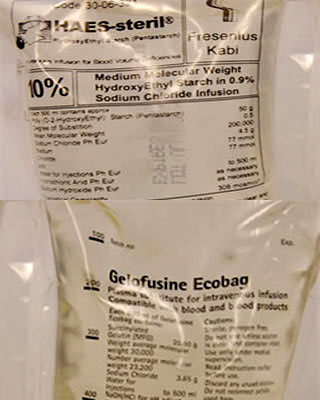Introduction
None of the crystalloid fluids stay entirely within the vascular space. They distribute through either the extracellular fluid or total body water. They would need to be given in large volumes if used for resuscitation following significant haemorrhage.
The colloids all contain large molecules that do not easily cross the capillary membrane and so remain in the intravascular compartment. This increases the colloid oncotic pressure in the capillary. Since fluid movement in and out of the capillary depends on the balance between the hydrostatic pressure gradient between plasma and interstitial fluid driving water out and the colloid oncotic pressure gradient pulling it in, water is retained.
Colloids therefore act as plasma expanders. Intraoperatively, they can be used to replace blood loss that does not trigger transfusion requirements or to 'buy time' until blood products are available following significant haemorrhage.
There are three groups of colloid to discuss:
- Modified gelatins
- Dextrans
- Etherified starches
